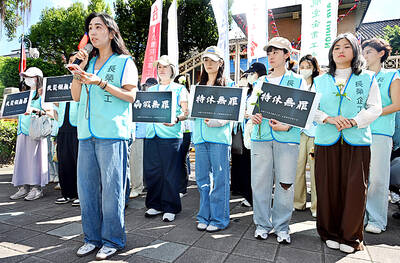China’s decision to send fighter jets across the median line of the Taiwan Strait on Sunday was intended to show Beijing’s dissatisfaction over warming Taiwan-US relations, a military expert said yesterday.
Two Chinese People’s Liberation Army Air Force J-11 fighter jets crossed the median line and entered Taiwan’s airspace at 11am on Sunday.
It was the first time since 1999 that the Chinese military had intentionally crossed the median line of the waterway, military sources said.
Chieh Chung (揭仲), a senior assistant research fellow at the National Policy Foundation, a think tank affiliated with the Chinese Nationalist Party (KMT), yesterday said that the operation reflected Beijing’s concern over more robust US support for Taiwan.
Foreign media have reported that the US will soon agree to Taiwan’s request to buy more than 60 F-16s, which would be the first US sale of new aircraft since 1992.
In addition, the two nations are holding a series of events this year in Taipei and Washington to mark the 40th anniversary of the Taiwan Relations Act, which serves as the basis of unofficial relations between Taiwan and the US.
These examples of warming ties have angered China and it responded by sending fighter jets over the median line, contravening a long-held understanding on the issue, Chieh said.
“It was meant to draw a red line, to tell the US not to ever cross it again,” he said.
A similar maneuver last occurred in 1999, when then-president Lee Teng-hui (李登輝) commented that Taiwan and China have a “special state-to-state” relationship.
That also angered Beijing, which later held exercises in the Taiwan Strait and sent military aircraft across the median line, Chieh said.
National Chung Cheng University Institute of Strategic and International Affairs assistant professor Lin Ying-yu (林穎佑) said that the median line issue also reflected a shift in the cross-strait military balance.
The air force had full control over the Taiwan Strait for decades, which made it impossible for Chinese jets to cross the line, but that has changed as Beijing has gained the upper hand in the cross-strait military balance, he said.
The concept of the median line was created in 1955 by US general Benjamin Davis Jr, commander of the US’ 13th Air Force, which was then based in Taipei, Chinese-language Military Link Magazine editor-in-chief Chen Wei-hao (陳維浩) said.
Since then, it has been very dangerous for Chinese aircraft to cross the line, because it would put them at a serious disadvantage as they would be targeted by Taiwanese fighters and radar, he said, adding that therefore, such intrusions rarely occurred.
Previous intrusions only lasted briefly and mainly occurred due to poor weather conditions, and on such occasions Chinese jets often returned to their side of the Taiwan Strait immediately after been warned by their Taiwanese counterparts, Chen said.
However, Sunday’s incident did not fall into that category and was a clear provocation, he said.
Chinese aircraft returned to China’s side of the median line only after receiving multiple radio warnings, the Ministry of National Defense said.
The intrusion triggered a 12-minute standoff between Taiwanese and Chinese warplanes, government officials said.

A drunk woman was sexually assaulted inside a crowded concourse of Taipei Railway Station on Thursday last week before a foreign tourist notified police, leading to calls for better education on bystander intervention and review of security infrastructure. The man, surnamed Chiu (邱), was taken into custody on charges of sexual assault, taking advantage of the woman’s condition and public indecency. Police discovered that Chiu was a fugitive with prior convictions for vehicle theft. He has been taken into custody and is to complete his unserved six-month sentence, police said. On Thursday last week, Chiu was seen wearing a white

The Taoyuan Flight Attendants’ Union yesterday vowed to protest at the EVA Air Marathon on Sunday next week should EVA Airway Corp’s management continue to ignore the union’s petition to change rules on employees’ leave of absence system, after a flight attendant reportedly died after working on a long-haul flight while ill. The case has generated public discussion over whether taking personal or sick leave should affect a worker’s performance review. Several union members yesterday protested at the Legislative Yuan, holding white flowers and placards, while shouting: “Life is priceless; requesting leave is not a crime.” “The union is scheduled to meet with

‘UNITED FRONT’ RHETORIC: China’s TAO also plans to hold weekly, instead of biweekly, news conferences because it wants to control the cross-strait discourse, an expert said China’s plan to expand its single-entry visa-on-arrival service to Taiwanese would be of limited interest to Taiwanese and is a feeble attempt by Chinese administrators to demonstrate that they are doing something, the Mainland Affairs Council said yesterday. China’s Taiwan Affairs Office (TAO) spokesman Chen Binhua (陳斌華) said the program aims to facilitate travel to China for Taiwanese compatriots, regardless of whether they are arriving via direct flights or are entering mainland China through Hong Kong, Macau or other countries, and they would be able to apply for a single-entry visa-on-arrival at all eligible entry points in China. The policy aims

The government yesterday donated US$200,000 to the Philippines to support post-earthquake relief and recovery efforts, following a powerful magnitude 6.9 quake that struck Cebu Province late last month, killing at least 72 people and injuring 559 others. The donation was presented earlier yesterday by Representative to the Philippines Wallace Chow (周民淦) to Cherbett Maralit, deputy resident representative of the Manila Economic and Cultural Office, at Taiwan’s representative office in Manila. In his remarks, Chow expressed concern for those affected by the magnitude 6.9 earthquake that struck the central Philippines on the night of Sept. 30. "We sincerely hope for the earliest possible